Super NAFTA Land
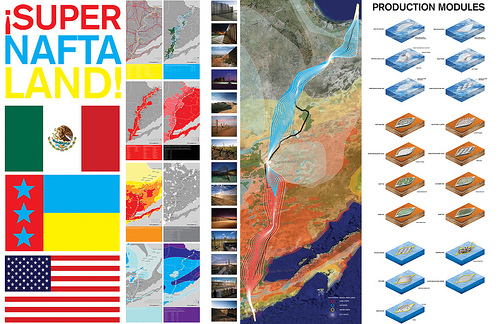 [Image: From ¡Super NAFTA Land! by Richie Gelles].
[Image: From ¡Super NAFTA Land! by Richie Gelles].Another project from the Rice University final thesis reviews that I helped to jury back in January is Richie Gelles's project ¡SUPER NAFTA LAND!.
That project imagines a kind of Mad Max salvage economy, made up of equal parts post-industrial subculture and bioengineered agri-futurism, set along the US/Mexico border.
Think of it as the sci-fi-inflected spatio-cultural wake of the North American Free Trade Agreement (or NAFTA) – falling somewhere between a new, continent-spanning red light district and a super-ranch run by Al Jourgensen.

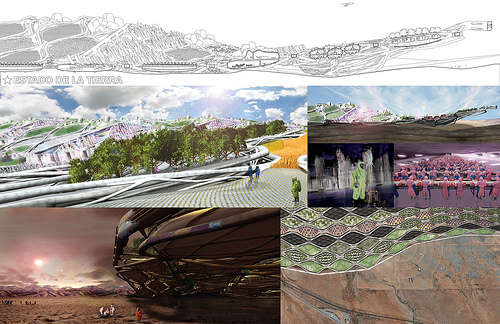
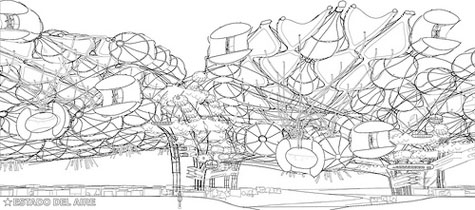
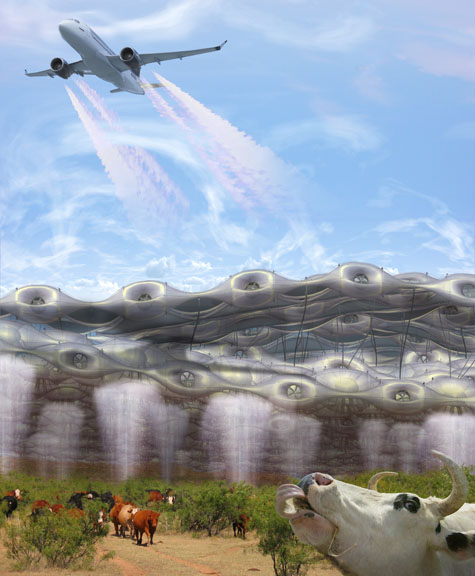
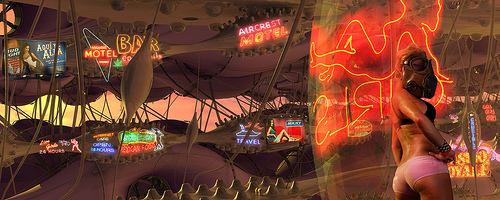 [Images: From ¡Super NAFTA Land! by Richie Gelles; be sure to view the sections much larger: Estado de la Tierra and Estado del Aire].
[Images: From ¡Super NAFTA Land! by Richie Gelles; be sure to view the sections much larger: Estado de la Tierra and Estado del Aire].This border region is "a dynamic, hybridized, and rapidly growing regional zone," Gelles writes, "known as 'Amexica' or the 'third space.'"
He continues, outlining the broader political intentions of the project:
- The emergence and potential of this "third space" as an economic engine and potential immigration buffer has been jeopardized by US policies towards Mexico such as the Secure Fence Act of 2006, which insists on understanding the border as a line, rather than its reality as a blurred zone of transition. This project proposes building a thickened, connective infrastructural corridor landscape to unite the sister cities (in place of the divisive 700 miles of fence currently under construction by the US government) and generate the resources and conditions for an independent, neutral border nation to emerge.
Awesomely, Gelles's vision of an Estado de la Tierra and an Estado del Aire includes linked megastructures assembled for the purpose of aeroponic gardening.
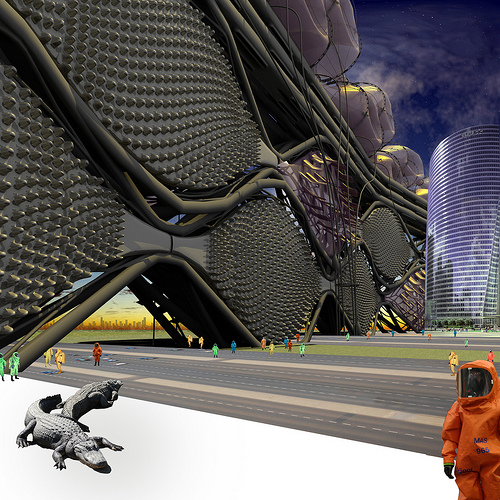 [Image: From ¡Super NAFTA Land! by Richie Gelles].
[Image: From ¡Super NAFTA Land! by Richie Gelles].It's the borderzone as micronation.
Read a bit more about the project through Gelles's Flickr set – or, even better, stop by his Tumblr site for further updates. For what it's worth, ¡SUPER NAFTA LAND! could easily become a much larger, long term research project, similar to Fernando Romero's Hyperborder; I'll be interested to see where Gelles might take this.
(¡SUPER NAFTA LAND! was produced at Rice University under the direction of Carlos Jimenez. Thesis advisors were Eva Franch Gilabert and Fares El Dahdah; thesis readers were John Casbarian, Albert Pope, and Fiamma Montezemolo).





Comments are moderated.
If it's not spam, it will appear here shortly!
I like seeing the Mexico/America border in a North/South layout. Well done.
what a mess. low hanging fruit - give us a little more to look for on BLDGBLOG. These Rice projects tend towards narcissistic displays of structure that disregard the occupants of the ground beneath.
give us your good old stuff - enough of misled, theoretical academic work
Why do so many architectural investigations propose growing crops on buildings rather than in the earth that those buildings displace? Disney Imagineered this into our popular imagination in the early 1980s--ride EPCOT and see the hydroponic tomatoes (and see them wither and die the moment there's a plumbing issue or the nutrient misters clog). Designing buildings is not license to subvert millennia of land stewardship and animal husbandry. It's increasingly disconcerting that the design community grabs onto projects that seek to replace rather than build from and augment our shared knowledge of how to live on this planet.
It's a speculative project (closer to scifi), no need for moral aggrandizing. There's nothing wrong with the occasional "Architectural Conjecture,Urban Speculation, Land Futures." That's what the blog is about and some of us enjoy it. Plenty of articles about Broadacre City floating around the internet if that's what you're looking for... although I had no idea there was an anti-green roof movement brewing out there, guess we should go back to 4-ply.
To the second Anonymous: Maybe aeroponic / hydroponic farming would be superfluous in another context, but along the border water is an increasingly scare resource. In the most pressing instance El Paso / Juarez will be unable to meet their expected water demands in less then 10 years. Most of the water that is used in the border region is used for agriculture, an astonishing 80% of New Mexico's water is used solely on irrigation. Aeroponic / hydroponic farming uses as little as 1/20th the amount of water that traditional soil based farming techniques do, and it has been proven successful in examples such as EuroFresh Farms in Arizona. In order to have a truly independent neutral nation between the US and Mexico, it seemed like a good idea for the new country to have it own food supply, but without any water there wouldn't be much point in that. Traditional farming techniques would be unsustainable in this scenario given the projected scale of demand and the scarcity of water.
for all the super cool renderings, there is a bit too much testosterone here. are all the guys in closed suits so they don't contaminate while the only woman is dressed as a likely prostitute? for all his north south reversals, nobody told the designer that america is the name of the continent, not the country? a lot of the reversals he's trying to make are still present in his boards. i say this utopia looks like more extreme version of empire.
This Rice project and a few of the others you've posted seem to fall into a category of "neo-dystopianism": a highly cynical and dark vision of the future, in which dayglo supergraphics become a kind of sheen over an otherwise hopeless political situation.
Just look at the oompaloompas wandering the border-zone in hazmat suits. The black insectoid carapaces hovering ominously over the entire landscape, churning out a kind of soylent-green algae. What kind of world are these designers living in? It makes me long for the bright, trippy creations of Archigram and Superstudio, which at least made their megalomaniac visions positive in nature.
I think this project and the one based in Israel have been far too influenced by Bladerunner. That future never happened. We don't live in a bleak night-city of permanent acid rain (however bad the current economic or political landscape seems to be.) Ultimately, isn't architecture about addressing critical issues in a way that helps, rather than designing massive panoptic systems that only seem to make the future more depressing?
Just a thought......
The technical sections are great, but then I like technical drawings of sci fi stuff. I'm less convinced about the megastructure itself as a response to the political situation, the two seem to be coming from completely different areas and not mixing very well (like the last RISD project).
The megastructure is an autonomous technical instrument that could go anywhere where resourcing is an abstract problem and has that bucky fuller dropped-from-an-apache-imperialist-rationalism whilst the judgements concerning the border seem open to something that's a bit more like shrewd realpolitik; vassalage states as outsourced immigration control or human resources as foreign relations. I think creative speculation in that direction, grounded in the reality of political and global networks tells us a lot more about the current political condition than another hydroponic megastructure, which just takes the border as some sort of tatooinesque stage set of stock transgression and alienation. If the premise is just a backdrop why bother? After all hydroponic megastructures are neither new nor entirely speculative (not if you like burtynsky), they're more like the mastercard of speculative suspensions of disbelief; the standard sci fi refrain, accepted everywhere. This isn't an argument against speculations, it's an argument for better speculations, after all archigram's megastructures were new reactions to the emerging political economy, not just a recognisable trope.
So I'm curious as to why this image (which I think is great and more politically sophisticated than the megastructure) wasn't developed further. In a similar vein I quite like the other student borderzone that gelles links to on his tumblr, he seems to have more fully engaged the issues at play even if the representation isn't finalised yet.
I am also (perhaps naively) hopeful that architecture is not fundamentally a cynical profession. I am hopeful that our speculations are ultimately geared toward improving the world, rather than wallowing in cynicism and negative dialectics.
These projects owe a lot to Koolhaas and his heirs (who in turn draw from Archigram et al.) But Koolhaas is fundamentally against cynicism. Yes, many of his proposals are tongue in cheek, but rather than amplifying dystopic conditions and symptoms, he cleverly erases them. I'm feeling like "Super NAFTA Land" is trying to make fools of us by amplifying cynicism: "the border is a dysfunctional place, so let's make it MORE dysfunctional, MORE cynical, MORE debased, MORE martial." If this is all just a critique of the condition of the border, then fine. But shouldn't there be some attempt in here to ameliorate a negative condition as well? Ultimately, this is the advantage that architecture has over, say, art or literature or even cinema: it can fix things. Indeed, it has an obligation to (doesn't it?)
I find these kinds of projects to be more of an exploration of form than a solution to the problems they cite. The designer states that the project "is a critique of the increasingly militarized linear border as nothing more than ineffective if deadly and expensive political theater," yet proposes a project that could only be implemented by a dictatorial, anti-democratic government.
But my feeling is that architectural form is not some inert gas: it's not there just to be attractive and sexy. Form, and particularly form as expressed by this designer, has consequences. His form is generated from a political logic, so I don't think that we can divorce it from its political implications.
I'm feeling like "Super NAFTA Land" is trying to make fools of us by amplifying cynicism: "the border is a dysfunctional place, so let's make it MORE dysfunctional, MORE cynical, MORE debased, MORE martial."
I read that and wondered if we were looking at the same project! In so far as it's "amplifying cynicism", it's by photoshop, not architecture. I mean I'm trying to find moments where people interact with the the architecture in an extended way and it's pretty much an activity taking place in isolation inside a single volume, or loitering outside of it. There are no sequences except those of resource flow at 1:5000. That's the scale where most of the creativity seems to have been concentrated, it's hard for me to identify any of those qualities at the human scale of building and I don't think photoshopping in figures is enough. I don't think the form was generated by a political logic at all, I think it was generated by an uncritical idea of resource provision and rote transgression. It's easy enough to hypothetically drop one of these things on any desert, jungle or sublime expanse of nature where it's ostensibly "infeasible" to work the land.
Matt, Im sure you have seen Koolhaas's Exodus project. I would say Koolhaas does "amplify dystopic conditions and symptoms" with that project. Exodus amplified all of the neurotic impulses Koolhaas saw within the city and produced what I think are highly dystopian images. Maybe he "cleverly erases [dystopian conditions and symptoms]" through his later work, but with his thesis project, I would beg to differ. I think almost all of the Rice projects posted here fall into the tradition of Exodus, for better or worse.
Well (going back on my previous statements) maybe it's ok to amplify cynicism as critique. It seems very hipster-chic.
I do think the project is graphically and technically interesting. My initial comment was really that the projects posted here from Rice all seem fairly dystopian—perhaps that's the mood in academia right now, or in the country.
But I also think there's a mode of critique that tries to ameliorate negative social conditions while still being tongue-in-cheek (see Winy Maas's proposal for Katrina housing, or Koolhaas's initial proposal to put a homeless clinic in the Seattle Library, which was never implemented.)
At about the same age as the author of this project I took on a thesis very similar in spirit to this one. My final critique was dismal--a total jaw-dropper--and I think my panel was far kind that day. I shudder to think of this moment even today. My arguments were very misguided.
Luckily for its creator, he has tremendous skill. His project far surpasses mine for its visual qualities. He also pushes himself into taking on a staggering complexity of something like NAFTA. His boldness will take him far. He should keep after this NAFTA thing.
If he's like me, I don't think he wanted to have a concept at all. I suspect he's actually passionate about global issues, but he struggles to articulate them on their own. His designs reflect this frustration.
The good news I have for its creator is that very soon he'll get to go out there and build stuff, and the political questions he faces as a professional will be at a manageable scale. The weight of the world, the weight of NAFTA will be off his shoulders on a performance basis. He can take it on in his spare time.
Eventually--soon even--it'll start to make sense.
For all the talk of NAFTA and "third" space and water, not a single mention of Canada — the third nation of NAFTA and the one with all the water.
Even odder when you consider that Canada is the USA's largest trading partner (and has been for years), and that their border is the longest shared border in the world. I guess there's no fear of the 'other' to sex it all up though.
the future is the present.
looks like a mixture between OMA - AMO and supersudaca..
WOW..
VERDEciudad
Post a Comment